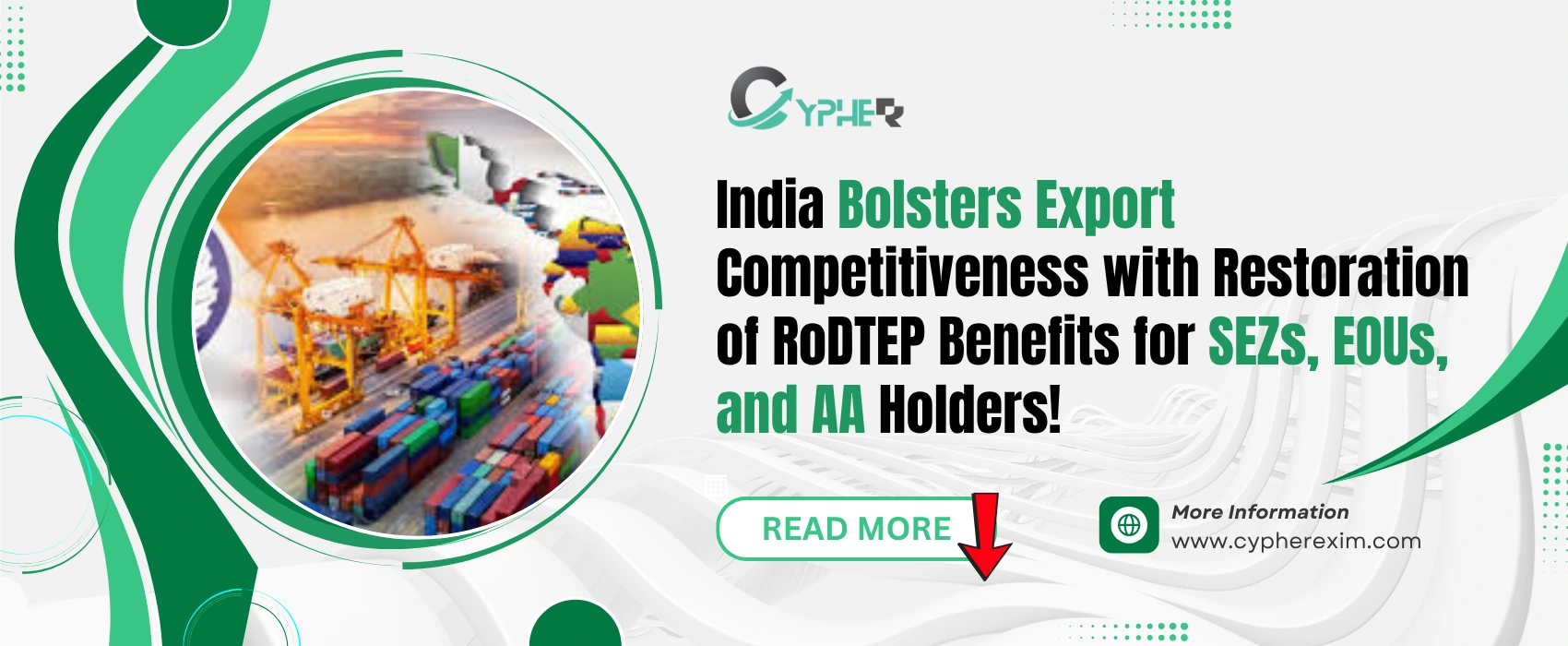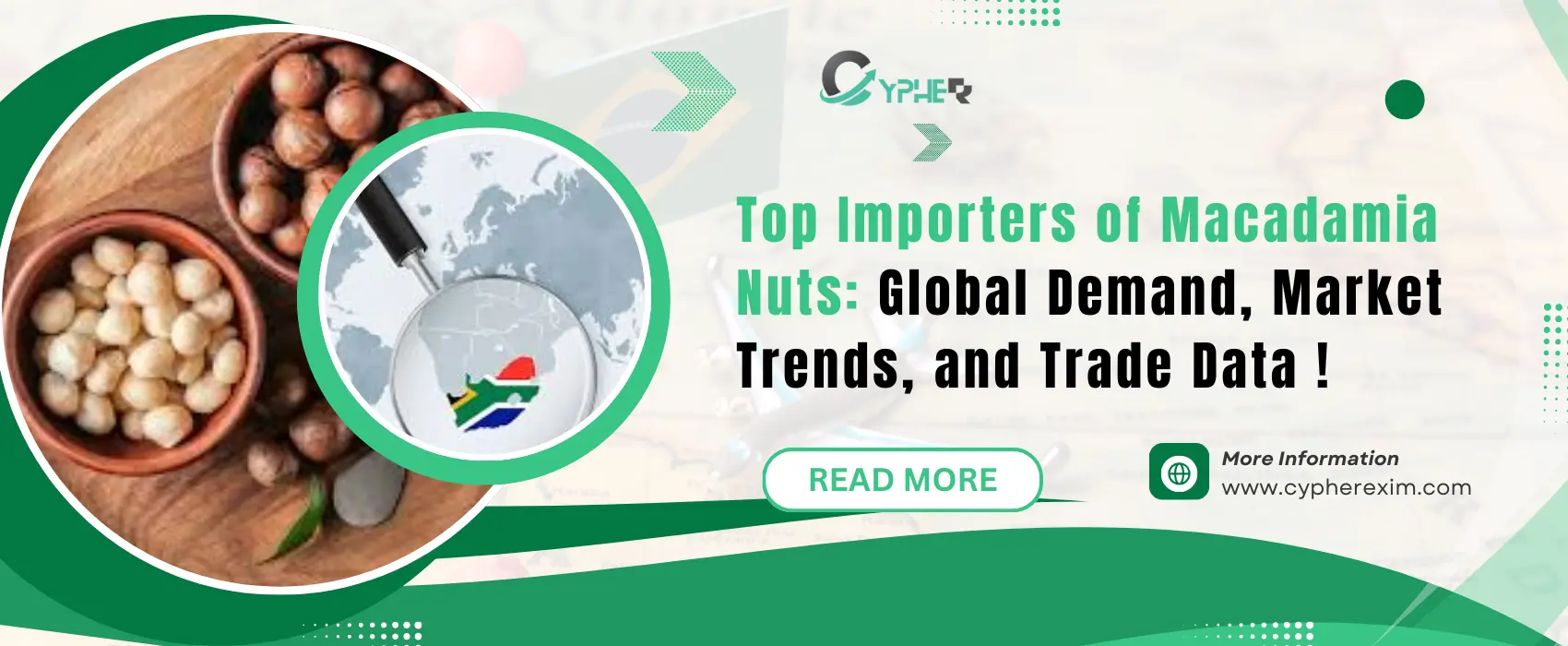India Bolsters Export Competitiveness with Restoration of RoDTEP Benefits for SEZs, EOUs, and AA Holders

27 May 2025
Introduction
The Indian government announced on May 27, 2025, that, as of June 1, 2025, Advance Authorisation (AA) holders, Export-Oriented Units (EOUs), and units operating in Special Economic Zones (SEZs) would once again be eligible for benefits under the Remission of Duties and Taxes on Exported Products (RoDTEP) scheme. In a difficult global trade environment characterised by economic uncertainty and rising trade tensions, this calculated effort seeks to increase India's export competitiveness. The Directorate General of Foreign Trade (DGFT) made the announcement, which is a big move to help exporters who were previously shut out of the program. It will also ensure fair competition and increase India's visibility in global markets.
Background of the RoDTEP Scheme
The Merchandise Exports from India plan (MEIS) was declared non-compliant with World Trade Organisation (WTO) regulations after a challenge by the United States in 2018. The RoDTEP plan was introduced in January 2021. Central, state, and municipal taxes and tariffs paid during the production and delivery of exported commodities that are not otherwise refunded through other channels are intended to be compensated under the RoDTEP program. This includes levies included into the supply chain, such as fuel and electricity tariffs, which can raise the price of goods that are exported. The program guarantees that Indian exports maintain their competitiveness in international markets by offsetting these expenses.
With refund rates ranging from 0.3% to 4.3% of the Free on Board (FOB) value of exports, subject to particular limitations for certain products, the program initially included 8,555 tariff items. By 2023, there were over 10,000 qualifying items thanks to the scheme's gradual expansion to include other industries like chemicals, pharmaceuticals, and iron and steel. With ₹27,018 crore returned to exporters by March 2023, the RoDTEP plan has provided substantial financial support, highlighting its crucial role in India's export strategy.
Expansion to SEZs, EOUs, and AA Holders
Three important exporter categories that were previously excluded—Advance Authorisation (AA) holders, Export-Oriented Units (EOUs), and Special Economic Zone (SEZ) units—now have access to RoDTEP incentives again thanks to the most recent declaration. In India's export ecology, several organisations are essential. SEZs function under a unique regulatory framework to encourage exports, EOUs are units specifically focused on exports, and AA holders buy inputs duty-free for export manufacturing. Industry organisations such as the Export Promotion Council for EOUs and SEZs (EPCES) have argued that there is \"no justification\" for excluding these categories from the incentives that are accessible to exporters in Domestic Tariff Areas (DTAs).
The resumption, which takes effect on June 1, 2025, is in line with the government's overarching goal of enhancing export performance in the face of global economic challenges, such as retaliatory actions from nations like China and U.S. tariffs imposed under President Donald Trump's administration. As demonstrated by previous calls in January 2025 to extend RoDTEP advantages to SEZs and EOUs until September 2025, the decision satisfies industry needs. It is anticipated that the action will give exporters in these categories a financial boost, allowing them to compete more successfully in global markets where prices are sensitive.
Economic Context and Global Trade Challenges
The restoration of RoDTEP benefits comes at a critical juncture for India’s export sector. Global trade is facing significant disruptions, with U.S. tariffs threatening to escalate into a broader trade war. Reports indicate that China has increased tariffs on U.S. imports to 125%, impacting American farm products and prompting a flight from U.S. assets. Meanwhile, India’s $283-billion IT sector is bracing for a challenging year due to potential U.S. recession fears, which could reduce client spending. The Indian government is also negotiating a trade deal with the U.S., contemplating tariff cuts on over $23 billion of U.S. imports to shield $66 billion in Indian exports from reciprocal tariffs.
The RoDTEP program is a vital instrument for preserving export competitiveness in this unstable climate. The program lowers exporters' costs by returning hidden taxes, enabling them to set more competitive prices for their goods. The tea industry, for example, has pointed to increasing competitiveness in international markets as a direct advantage of successfully lobbying for an increase in the RoDTEP incentive cap from ₹3.6 to ₹6.7 per kilogramme in 2023. The leather and footwear industry has also praised the program's expansion to SEZs and EOUs, pointing out that it could improve price competitiveness.
Industry Reactions and Expectations
Industry groups have overwhelmingly approved of the reintroduction of RoDTEP benefits. The action was characterised as a timely intervention to assist exporters in navigating global challenges by Sanjay Budhia, Chairman of the CII National Committee on EXIM. The Indian Tea Association conveyed appreciation for previous hikes in RoDTEP rates, which have increased the competitiveness of Indian tea on a worldwide scale, while the Council for Leather Exports emphasised the scheme's contribution to increasing the competitiveness of leather and footwear products.
Nonetheless, certain trade associations, like the Tea Association of India, are still pushing for higher RoDTEP rates in order to equal or surpass the 5% incentive that was previously provided under MEIS. Some industries believe that the present rates, which range from 0.3% to 4.3%, are not enough to completely compensate for the cost disadvantages in international markets. The government has also made it clear that the advantages of the scheme would be modified to remain within the authorised financial framework, which may entail making necessary revisions to rates, quotas, or eligible items.
Implementation and Future Outlook
Details are accessible in Appendix 4RE on the DGFT portal. The DGFT has revised the RoDTEP rates to reflect the Finance Act 2025 HS codes. It is anticipated that the restoration of benefits for SEZs, EOUs, and AA holders will simplify export procedures and lessen the financial burden on these entities. Additionally, the ministry of commerce has pledged to create the IT infrastructure required to facilitate the scheme's execution, especially for e-commerce exports, which were incorporated into the RoDTEP framework in December 2023.
The RoDTEP program is expected to continue to be a vital component of India's export promotion strategy in the future. It was earlier referred to by Commerce Secretary B V R Subrahmanyam as a “long-lasting scheme” that complies with WTO regulations and covers 95% of tariff lines in addition to the Rebate of State and Central Taxes and Levies (RoSCTL) scheme for clothing and apparel. The government's proactive efforts to broaden the program's reach and resolve business concerns demonstrate its dedication to reaching aggressive export goals, like $2 trillion in yearly exports by 2030.
Restoring RoDTEP incentives for AA holders, EOUs, and SEZs on June 1, 2025, is a calculated step to bolster India's export industry amid global uncertainties. The program enhances India's competitiveness in key sectors like tea, leather, and IT by addressing the cost disadvantages faced by exporters. In an environment shaped by U.S. tariffs and potential trade wars, the RoDTEP scheme provides Indian exporters with a much-needed buffer as global trade dynamics evolve. Access to reliable Customs Data and detailed Custom Trade Data further strengthens exporters’ ability to track market trends, optimize pricing strategies, and identify growth opportunities. Combined with strong government support and consistent industry advocacy, the RoDTEP program is well-positioned to drive India’s export expansion in the coming years.
Sources:
- Economic Times, May 27, 2025
- Business Standard, January 6, 2025
- Business Standard, September 30, 2024
- Reuters, March 25, 2025
- Times of India, January 18, 2023
- Posts on X, May 27, 2025







